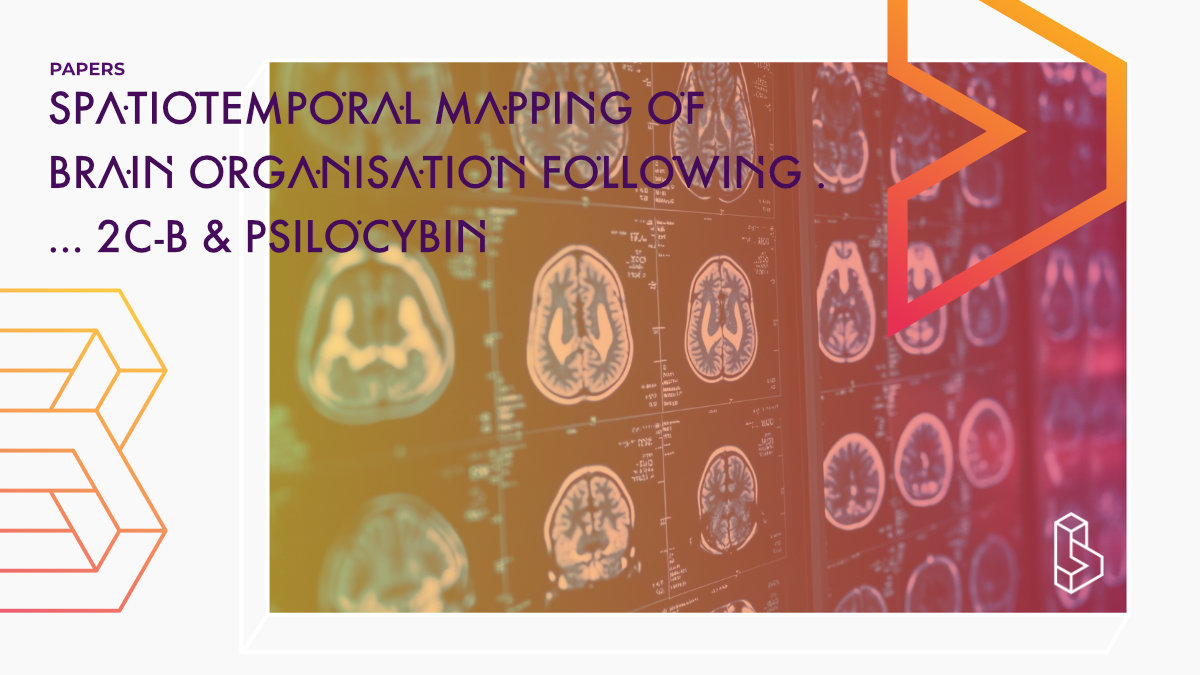This pre-print, double-blind, placebo-controlled crossover study (n=22) investigates the neural effects of 2C-B (20mg) compared to psilocybin (15mg) and placebo using 7T resting-state functional MRI. The results reveal that both 2C-B and psilocybin reduce intra-network connectivity while enhancing between-network connectivity, with 2C-B showing less impact on certain connectivity measures but greater transmodal connectivity.
Abstract of The forgotten psychedelic: Spatiotemporal mapping of brain organisation following the administration of 2C-B and psilocybin
“As psychedelic-assisted psychotherapy gains momentum, clinical investigation of next-generation psychedelics may lead to novel compounds tailored for specific populations. 2,5-dimethoxy-4-bromophenethylamine (2C-B) is a psychedelic phenethylamine reported to produce less dysphoria and subjective impairment than the psychedelic tryptamine psilocybin. Despite its popularity among recreational users and distinct pharmacodynamics, the neural correlates of 2C-B remain unexplored. Using 7T resting−state functional MRI in 22 healthy volunteers, we mapped out the acute effects of matched doses of 20 mg 2C-B, 15 mg psilocybin and placebo across spatiotemporal benchmarks of functional brain organisation. In a within-subjects, double-blind, placebo-controlled crossover design, we evaluated the neuropharmacological and neurobehavioural correlates of an array of connectivity measures – including static (sFC) and global connectivity (gFC), dynamic connectivity variability (dFC), and spontaneous brain complexity. Compared to placebo, 2C-B and psilocybin selectively reduced intra-network sFC, while broadly increasing between-network and subcortical-cortical connectivity. Compared to psilocybin, 2C-B exhibited less pronounced reductions in between-network FC but elicited elevations in transmodal sFC. Both compounds yielded spatially divergent increases in gFC yet produced similar increases in brain complexity. Using PET density modelling, the spatial distribution of neural effects aligned with documented differences in monoaminergic transporter and serotonergic receptor binding affinity beyond 5-HT2A, highlighting the role of pharmacology in shaping functional dynamics. Lastly, we show behavioural markers of psychedelic effects are non-linearly reflected by the desynchronisation of the transmodal axis of functional brain organisation. Together, our findings highlight 2C-B as a useful new addition to the study of psychedelic neuroscience and may motivate new pharmacotherapy strategies.“
Authors: Pablo Mallaroni, Parker Singleton, Natasha L. Mason, Theodore D. Satterthwaite & Johannes G. Ramaekers
Summary of The forgotten psychedelic: Spatiotemporal mapping of brain organisation following the administration of 2C-B and psilocybin
The field of psychedelic research has seen growing interest in their potential therapeutic applications for various neuropsychiatric disorders. Current research indicates that classical psychedelics, such as psilocybin, achieve their therapeutic effects primarily by temporarily disrupting normal brain function through their interaction with serotonin 2A (5-HT2A) receptors. Studies using resting-state functional magnetic resonance imaging (rsfMRI) have shown that these substances typically decrease blood-oxygen-level-dependent (BOLD) signal variation and increase functional connectivity across the brain’s cortex. These findings support theories that suggest psychedelics work by reducing the separation between brain networks and increasing neural complexity.
As the field advances, researchers are increasingly interested in next-generation psychedelics that might produce similar brain effects. The development of compounds that create milder, shorter, or more manageable altered states of consciousness could be more practical for clinical use while offering new insights due to their different pharmacological properties. One such compound is 2,5-dimethoxy-4-bromophenethylamine (2C-B), which is currently the most commonly used novel psychedelic among recreational users. Despite having some history of therapeutic use, very little clinical research exists on its effects. Compared to psilocybin, 2C-B appears to cause less subjective impairment and negative emotions at similar doses, while producing comparable perceptual and cognitive effects.
The distinct effects of different psychedelics likely stem from their varied interactions with brain chemistry (polypharmacology). Different neurotransmitter systems influence how brain regions communicate, leading to distinct network-level effects. While some studies have retrospectively examined these relationships across different psychedelics, there is a lack of within-subject comparative studies that would minimise variation between studies and participants. Furthermore, various rsfMRI approaches have been used to measure psychedelic experiences with varying degrees of success. Rather than trying to determine which single measure is best, a more practical approach may be to identify specific brain regions that respond differently to various psychedelics, regardless of the measurement method used.
Methods
Participant Selection and Study Design
Find this paper
https://doi.org/10.1101/2024.10.22.619393
Open Access | Google Scholar | Backup | 🕊
Cite this paper (APA)
Mallaroni, P., Singleton, P., Mason, N. L., Satterthwaite, T. D., & Ramaekers, J. G. (2024). The forgotten psychedelic: Spatiotemporal mapping of brain organisation following the administration of 2C-B and psilocybin. bioRxiv, 2024-10.
Study details
Compounds studied
2C-X
Placebo
Psilocybin
Topics studied
Neuroscience
Healthy Subjects
Study characteristics
Original Re-analysis
Placebo-Controlled
Active Placebo
Double-Blind
Within-Subject
Randomized
Bio/Neuro
Participants
22
Humans
Institutes
Institutes associated with this publication
Maastricht UniversityMaastricht University is host to the psychopharmacology department (Psychopharmacology in Maastricht) where various researchers are investigating the effects of psychedelics.
Compound Details
The psychedelics given at which dose and how many times
2C-X 20 mg | 1x Psilocybin 15 mg | 1xLinked Research Papers
Notable research papers that build on or are influenced by this paper
Assessment of the acute effects of 2C-B vs psilocybin on subjective experience, mood and cognitionThis double-blind study (n=22) compares the effect of 2C-B (20mg) and psilocybin (15mg). It finds that 2C-B elicited alterations in consciousness of a psychedelic nature but with a shorter duration of self-reported effects than psilocybin. The study categorised 2C-B (at least at that dose) as a subjectively "lighter" psychedelic.
Psilocybin and 4-Bromo-2,5-Dimethoxyphenethylamine (2C-B) at Encoding Distort Episodic Familiarity
This re-analysis of an RCT study (n=20) tested the acute effects of psilocybin and 2C-B on the encoding of emotional episodic memories. The study finds that both psychedelics impair estimates of recollection and familiarity, increase familiarity-based false alarms for emotional stimuli, and affect metamemory, indicating a common neurocognitive mechanism across these drugs.
Linked Clinical Trial
Sub(acute) Profiling of 2C-B Versus PsilocybinThis interventional study, named PREDICT and conducted by Maastricht University, aims to comprehensively evaluate the acute and subacute effects of 2C-B compared to psilocybin and a placebo.

